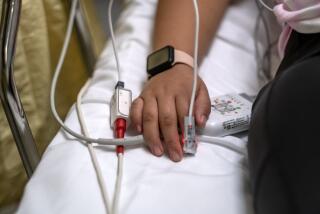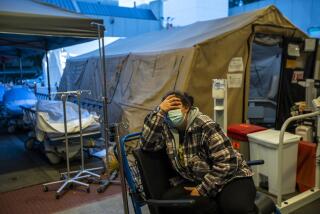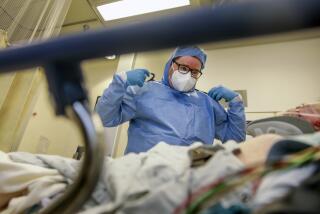Officials Doubt Disaster Readiness
- Share via
Health officials in Southern California say the region is not sufficiently prepared to respond to a major biological assault or the immediate aftermath of a large-scale disaster that leaves thousands seriously injured.
Experience with past disasters and mock drills suggest that some treatable patients would die before medical assistance arrived from neighboring counties and the federal government.
A major concern is that Los Angeles County has even fewer hospital beds than it did in 1994, when the last major regional disaster, the Northridge earthquake, occurred. In Los Angeles County alone, 19 hospitals and several emergency departments have closed.
“The [hospital] capacity is gone,” said Virginia Hastings, director of emergency medical services for Los Angeles County. “We all need to look at this, even for a flu season or a good earthquake, let alone 5,000 people that may be injured by a bomb.”
Earthquakes and riots have prepared Southern California in some measure for disasters. But the region is at a disadvantage compared with the rest of the country because of its immense sprawl and an especially beleaguered public health system chronically starved for funds.
In Los Angeles County, officials say, hospitals are short of basic protective gear needed for a biological or chemical attack and authorities aren’t certain which hospitals have what supplies.
A lot depends, of course, on what type of disaster the system faces and what sorts of casualties result. In New York on Sept. 11, many of the victims died; injured people did not stretch the medical system’s capacity. Still, the attack caused health experts to wonder if the system in New York and elsewhere would fare as well if thousands of people suddenly suffered serious injuries.
Even in normal times, some emergency rooms in Los Angeles County become so crowded on weekends that they must close their doors to ambulances. For those who walk in, waits for treatment in emergency rooms can stretch into hours.
Added to that is a severe nursing shortage and one of the highest rates of uninsured residents in the nation. Trauma centers are threatening to close, and health officials are contemplating shutting entire public hospitals if Washington goes through with proposed funding cuts.
‘Reasonable Amount of Planning’
“You’re dealing with a health care system that’s stressed out to begin with,” said Dr. Brian Johnston, an emergency room physician and past president of the county medical association. “If we had a major problem in L.A. County tonight or tomorrow we would have a serious difficulty meeting the need.”
Jim Lott, executive vice president of the Healthcare Assn. of Southern California, said regional hospitals, which normally are 75% to 90% full, do not have the extra capacity to respond to a major terrorist attack with many casualties.
Hospital executives say the region has tried to put together contingency plans and has long-standing pledges from neighboring areas to send doctors and supplies. But it takes 12 to 24 hours to bring in reinforcements from other counties and to secure military aircraft to help transfer patients elsewhere, Hastings said.
“If we had 10,000 casualties in this town, that would be overwhelming, no matter how well you planned,” said Dr. Michael Karpf, vice provost of UCLA Hospital Systems and director of UCLA Medical Center.
Still, he said, it would be a mistake to think everything would be “helter-skelter because that’s not the case. . . . There’s been a reasonable amount of planning in this town and it has been taken quite seriously.”
Public health officials also question whether scarce resources are best spent preparing for a disaster that may never happen. Those funds are needed to address chronic health problems--to immunize poor children, for example, or to treat diabetes and educate people about asthma, officials say.
“It’s hard to say, ‘Let’s put all our resources into being prepared,’ and then . . . the rooms lie fallow, the equipment lies fallow,” said Dr. Laurene Mascola, chief of the county’s acute communicable disease control unit. “People want to be prepared all the time for everything, and you can’t be.”
Los Angeles has some experience with disasters--and though it has proved instructive, it does not necessarily bode well. Consider the 1994 Northridge earthquake: 57 people died and more than 16,000 sustained injuries (although most were minor). But at the time when they were most needed, 23 hospitals were so damaged that they had to suspend some or all services. Nurses and doctors had to set up beds in parking lots to process patients quickly.
Los Angeles County has been gearing up for a chemical or biological assault since it was rattled by a series of bogus anthrax threats in 1998 and 1999. But many of the 82 hospitals here are not equipped to treat patients coated in toxic chemicals, said Carol Gunter, assistant director of the county’s Emergency Medical Services.
The county does not have nearly enough decontamination suits for physicians to avoid spreading chemical agents or for isolation tents to house sick people. Such equipment is not required by law.
Simulated Attack’s Disturbing Results
“There’s going to have to be some sort of funding behind it, and . . . some sort of mandate,” Gunter said.
Since Sept. 11, the health department has been checking with private hospitals and reminding them of how to spot signs of chemical or biological attacks--the symptoms of which may not surface for days. None have been reported, officials say.
San Diego County officials last year did a computer simulation of an anthrax attack at a shopping mall and were taken aback at the results.
The simulation showed that thousands of people would become violently ill, most 48 hours or more after exposure. Hospitals would be quickly overwhelmed.
The San Diego County government hopes to develop a computerized system to link hospitals, physicians and epidemiologists as soon as the first patient is discovered with symptoms of poisoning by anthrax or other biological or chemical agents.
Health officials cautioned that each form of biological or chemical warfare is different and requires a unique response. But the initial challenge in most cases is containment of the threat more than treatment. And that can take time.
Dr. Shirley Fannin, Los Angeles County’s director of disease control programs, said she is worried that the county lacks adequate laboratories, disease investigators and communication strategies to deal with a biological or chemical attack. “I just have a feeling that we haven’t progressed far enough quite yet.”
But she warned against pre-attack panic, because it is counterproductive and there isn’t much individuals can do on their own to protect themselves.
“The biggest danger here is a panic that people get into and begin to demand unrealistic assurances and unrealistic preparations,” Fannin said.
*
Staff writer Tony Perry in San Diego contributed to this report.
More to Read
Sign up for Essential California
The most important California stories and recommendations in your inbox every morning.
You may occasionally receive promotional content from the Los Angeles Times.










